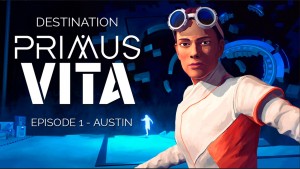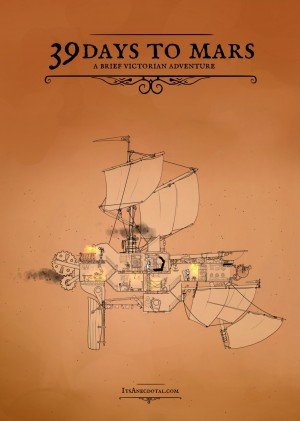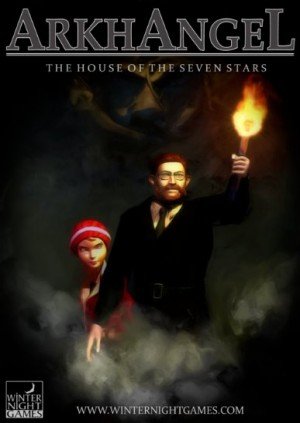Review for Abha: Light on the Path

Abha: Light on the Path is a curious little 2D point-and-click adventure by indie developer Little Angel. Set in a world that is part familiar, part fantasy and part science fiction, it incorporates elements from each in depicting its vibrant hand-painted landscapes. It’s fun enough to roam around in for a spell, but ultimately the lack of any deeper exploration of the history of this world or even its present-day narrative is a tad disappointing.
The eponymous heroine is a young a woman from a remote tribal village. She is one of the few survivors of an attack by the Spekys, technologically advanced aliens who wiped out most of the villagers. Having lost all her friends, Abha now seeks to leave her home so that she may see the stars, as she’s never once viewed the sky (although I never quite got that bit, as it is seemingly visible in several locations). Abha has a friend and mentor in Ether, the village alchemist. Early on he promises to help Abha on her quest, provided she first sneaks into a nearby Spekys garrison and frees the village chief Mannan, who went to rescue other villagers imprisoned there but was himself captured.
The protagonist’s journey leads her from the vibrant jungle surrounding her thatched hut village through a nearby savannah leading to the garrison. These natural environments are quite beautiful and have an air of magical realism about them with small green bubbles of oxygen wafting through the air. It’s never explained why, but the areas beyond the jungle are light on oxygen and heavy on dust, although this doesn’t factor into the gameplay experience anyway. In contrast to the lush landscapes, the metallic Spekys garrison is cold and rigid in its geometric lines and muted colours. A good job is done differentiating the ambience of the two different peoples.
When Abha finally returns to her own goal of finding the stars, her journey takes a somewhat metaphysical turn, leading her to places that are a bit less grounded in reality. Ancient ruins seem to be set on floating islands in the sky, although the surrealism of it all makes it a little difficult to say for sure. In any event, the sights on offer throughout the game are quite pleasing to observe, and most are alive with background details like clouds of insects and twinkling rays of light.
Although there’s a lot to see in Abha’s world, there’s very little information presented about it. It’s unclear who Abha’s people actually are. The Spekys seem to be invaders from another world, but that’s never explicitly stated, nor their reason for coming to the jungle and attacking the villagers. The thin atmosphere outside the forested regions isn’t discussed. Is it naturally that way? Is it a result of the conflict with the Spekys? Even Abha’s reasons for leaving the village seem rather thin. It feels like this is a game set in a world with a lot of potential depth that is never actually presented or realized in any way.
Despite being a short game, taking me only an hour and a half to play, Abha manages to fit in quite a variety of puzzles. Some are traditional inventory-based obstacles, with items displayed across the top of the screen by clicking on a backpack icon in the upper right corner. Also present throughout, however, are various close-up pattern-matching puzzles, a straightforward fishing minigame, and a couple of combination lock puzzles.
Of particular note is a sort of meditation-based type of task. Abha needs to learn to center herself from time to time by focusing on various concepts, such as fauna or the cosmos. During these sequences, her head is displayed on-screen with different words drifting in from the edges. Words that match the idea being contemplated need to be allowed in, such as “animal” or “butterfly” for the concept of fauna. Words that don’t match need to be moused-over to shoo them away. When enough good words reach the center, Abha passes her meditation.
There is also one stealth sequence where you have to guide the young woman and Chief Mannan through the Spekys garrison. Switching from the more traditional third-person view, this section is presented from a top-down perspective, showing the corridors of the base. A couple of Spekys are on patrol and you will have to navigate past them without being seen. Getting caught returns you to the start of the sequence to try again. It’s a little challenging, especially since a permanent dialog portrait of Mannan displays with a word bubble indicating that you must escape, which needlessly covers up a good chunk of the hallway leading to your exit, making it harder to spot the approaching Spekys before they see you.
Expect to encounter far more difficulty with a late game puzzle involving a trio of owls sitting in a tree. Clicking on an owl causes it to fly to the top of the screen before returning to its perch. Without spoiling the puzzle, it’s necessary to maneuver the owls in such a way that a key falls from the tree. The problem is that the owls don’t move in any sort of predictable fashion. Owls will interfere with each other when flying and, more often than not, have difficulty landing again, often jerkily circling around a branch rather than landing. It probably took me around twenty minutes of randomly clicking on owls before I got them to land correctly. In a game that is otherwise so short, this was a particularly frustrating scenario to run into and felt like nothing more than unwelcome padding.
Besides a few specialized activities, such as the fishing and meditation activities, gameplay is conducted in mostly typical point-and-click fashion. I say mostly as the interface is a little rough around the edges. Unlike a usual adventure, where clicking on a hotspot has the main character walk over and interact with that object in some way, here you are required to first click on or near an area of interest to get close to it before clicking again to actually interact with it. I found myself forgetting this on a couple of occasions, so Abha would wander over to a particular hotspot but would then just stand there until I remembered to click again. It’s not a big issue, but it’s such a basic thing that it could have been better streamlined.
The game lacks any sort of manual save system, providing only a single autosave. Normally this is a serious omission for me, but since Abha is so short and bereft of bugs, the autosave is enough to get by. I was worried at one point when I lost a couple of owls off-screen during their one extended sequence, but leaving and reentering the scene brought them back.
Abha doesn’t feature a lot on the audio front, but what it does have is quite well done. Most of the soundscape consists of ambient noises, such as the buzzing of bugs or the splashing of water, but there are many fantastical animals scattered throughout the game – such as the large Bantak, a sort of cross between a Triceratops and Stegosaurus, and another creature resembling a furry, wingless Pteranodon – and they all have convincing vocalizations. The game has very little music, mostly only playing when reaching a new location or passing a given obstacle. The tracks generally consist of short little piano tunes with a few additional instruments backing them up, feeling appropriate to their respective locations.
The people you meet and the protagonist herself go unvoiced. Dialog either takes place in the normal game view or within close-up, non-animated images of the characters speaking. In the former, clicking does nothing to move through the conversation, while in the latter, the mouse can be clicked to advance through the lines being spoken. The non-clickable dialog can be a bit distracting, as the text speed is rather slow and cannot be adjusted. Fortunately, most of the talking occurs in the close-up scenes.
All in all, Abha: Light on the Path is a fun, easy, short adventure that fits nicely between meatier fare. It presents a world that feels like it has a lot of hidden depth, so it’s a shame that it doesn’t pay it off by fleshing it out in any way. The visual design is well done, and there are enough intriguing hints of a richer, better story here that hopefully the developer will revisit this setting in the future, as I would love to delve deeper into the world behind their debut adventure.



























